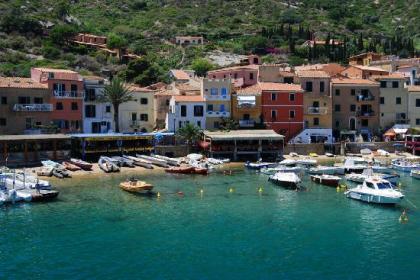
 A flower in the Tuscan archipelago: the island of Giglio. Walks and diving
A flower in the Tuscan archipelago: the island of Giglio. Walks and diving

filled by Giulia & Romeo

In front of the Argentario promontory , Giglio island is the second largest island of the Tuscan archipelago. High and steep granite shores alternate with beautiful sand beaches, pastel-colored houses, nature walks and interesting backdrops for divers.
The best time to visit the island is spring, when the lily blooms of color with all its flowers ... pink and yellow brush strokes, frolicking rabbits, the herring gulls that whistle, and even a few tourists. Not being an island very large for the high season is advisable to book well in advance, and structures ranging from camping to luxury hotels.
The island's capital is Lily Castle, at 405 m above sea level, surrounded by beautiful medieval town walls. It is part of "The most beautiful villages in Italy", with its loopholes, the trione, alleys, stairways and the three entrances to the huddled masses of granite. In November XXVIII Square is the Rock on the west side of Pisa and the Church of St. Peter, which houses the ancient weapons of the pirates, the relics of St. Maximilian, the patron saint of the island and the treasure of Pope Innocent XIII. From here you have a beautiful view on the island and other islands of the archipelago, Giannutri, Elba and Montecristo. Do not forget to visit the numerous wineries where it is produced and maintained the typical amber and rugged island wine, wine Ansonaco.
Giglio Porto is located in the bay of Scalettino and consists of a series of pastel houses, restaurants and bars built along the shore that in the evening switch on for locals and tourists. Behind him a mountainous amphitheater is the setting for this picture that seems natural oil painting by an Impressionist painter. To the south east tower Medici wanted to defend the attacks of pirates, the dock of the bay and the beautiful red buck with the remains of patrician villa Enobarbi.
Giglio Campese is a favorite destination of many tourists in the summer months, is a bay with white and fine sand, well served, the largest in the island and the longer sunlit. On the one hand the stack, the other Medicean tower. Sunsets on Monte Cristo are like postcards!
Giglio island is to live on foot, long walks with tennis shoes.
There are paths that start at Giglio Campese, of varying difficulty, including one that leads to Faraglione, which offers a spectacular view and that along the way he meets several beaches, including that of Pozzarello, pebbles and water, especially crystalline. Towards the interior, after a short climb, you open a wonderful limestone amphitheater, overlooking the sea, and you can reach the bay of alum. Footer traditional beaches, as well as that of Campese, are those of Cannelle, Caldane and Arenella. Other points are the beautiful white coastline of Punta Lazzaretto, Cala del Corvo, Punta Torricella and suggestive Punta Capel Rosso, at the end of the island, the beach with the lighthouse and the cliffs overlooking windswept.
From hiking to diving: divers will find in the depths of the lily of the island, especially along the southeastern coast is not accessible by land, a veritable paradise with water meadows of gorgonians, fish in schools, numerous sponges and some rarities like the stars gorgon.
Among the best known and most popular diving drops are Cala di Lupa, Le Scole, Punta delle Secche, Punta di Capel Rosso, Scoglio della Cappa…
Fenaia drop is instead a vertical wall for experienced divers that goes up to 90 meters, rich with wildlife and you can see the rare star Gorgon .
|
|






















